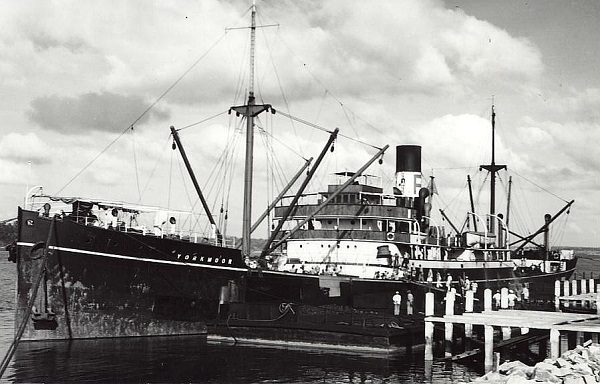Yorkmoor
British Steam merchant

Photo courtesy of Richard Cox
| Name | Yorkmoor | ||
| Type: | Steam merchant | ||
| Tonnage | 4,457 tons | ||
| Completed | 1925 - J. Readhead & Sons Ltd, South Shields | ||
| Owner | Walter Runciman & Co Ltd, Newcastle-upon-Tyne | ||
| Homeport | London | ||
| Date of attack | 28 May 1942 | Nationality: | |
| Fate | Sunk by U-506 (Erich Würdemann) | ||
| Position | 29° 30'N, 72° 29'W - Grid DC 5844 | ||
| Complement | 45 (0 dead and 45 survivors). | ||
| Convoy | |||
| Route | St. Thomas, Virgin Islands (23 May) - New York | ||
| Cargo | 6700 tons of bauxite | ||
| History | Completed in January 1925 | ||
| Notes on event | At 03.12 hours on 28 May 1942, U-506 began shelling the unescorted Yorkmoor (Master Thomas Harrison Matthews) north-northeast of Bahamas. The U-boat was returning from a very successful patrol in the Gulf of Mexico and had no torpedoes left, so the armed freighter (the ship was armed with one 4in and eight machine guns) was attacked from her port quarter at the limit of visibility in the moonlit night, a distance of about 2500 meters. The Germans could not clearly observe their shots despite firing star shells and only assumed that they scored hits when the distress signals stopped, but at the same time it made it difficult for the DEMS gunners to return fire as they could only aim at the gun flashes. One of the first shells hit the boiler room and disabled the port boiler, reducing the speed of the vessel and making it impossible to flee. Another shell hit underneath the gun platform, but without damaging the gun or injuring the gun crew. The next struck the poop under the counter and after that the most hit amidships, holing the engine room and #2 hold on the port side and badly damaging the deck in that area. The radio operator re-rigged the emergency aerial after both aerials had been brought down and kept sending signals. At 03.45 hours, the master ordered the crew to abandon ship as she was settling by the bow on even keel and eventually lost all power when the engine room flooded. The master, 40 crew members and four gunners abandoned ship in both lifeboats, but the port boat had been damaged by shell splinters and foundered so its occupants had to be picked up by the starboard boat. The Germans ceased fire after spotting the lifeboats, having fired about 55 rounds from the deck gun. The ship had returned fire with 19 rounds from the stern gun, although it did not damage the enemy the shells had kept him on distance. At 04.20 hours, the Yorkmoor sank by the bow with a 45° list to port after a boiler explosion in position 29°54’30N/72°25’30W. The U-boat quickly left the area after the master was questioned. After the U-boat left, the men in the overcrowded lifeboat decided to right the swamped boat, so the chief officer and some men were transferred into it and they worked the rest of the night to repair the splinter damage and to bail it out, while the other boat collected the provisions from the rafts that had floated free. Subsequently the lifeboat in charge of the chief officer took 17 men aboard and both boats set sail to the west-northwest in calm weather with a slight swell. On 30 May, the weather deteriorated towards evening with strong wind and rough seas. The master then instructed the chief officer to proceed independently because his boat could sail faster and they lost contact during the next night. In the evening on 31 May, the occupants in the repaired boat were picked up by Laguna after attracting her with flares in position 32°00N/75°46W and landed at Charleston, North Carolina on the next day. On 4 June, the men in the boat of the master were picked up by a US Coast Guard cutter after being spotted by aircraft and taken to Morehead City, North Carolina. There were no casualties and except sunburn all survivors were in good health. | ||
| On board | We have details of 23 people who were on board. | ||
If you can help us with any additional information on this vessel then please contact us.
